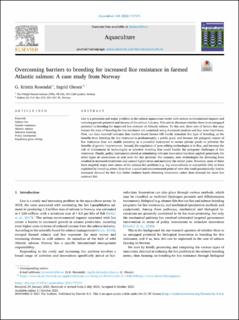Overcoming barriers to breeding for increased lice resistance in farmed Atlantic salmon: A case study from Norway
Peer reviewed, Journal article
Published version
Permanent lenke
https://hdl.handle.net/11250/3007131Utgivelsesdato
2022Metadata
Vis full innførselSamlinger
Originalversjon
10.1016/j.aquaculture.2021.737574Sammendrag
Lice is a persistent and major problem in the salmon aquaculture sector with serious environmental impacts and reducing growth potential and income of the salmon industry. This article discusses whether there is an untapped potential in breeding for improved lice resistant of Atlantic salmon. To this end, three sets of factors that may impact the state of breeding for lice resistance are examined, using document analysis and key actor interviews. First, our data material indicates that market-based factors will hardly stimulate this type of breeding, as the benefits from breeding for lice resistance is predominantly a public good, and because the polygenic nature of lice resistance does not enable patenting as a powerful instrument to secure private goods or privatize the benefits of genetic improvement. Second, the regulation of gene editing technologies is in flux, and increase the risk of investments in technologies as selective breeding that could handle the polygenic challenges of lice resistance. Finally, policy instruments aimed at stimulating relevant innovation has been applied generously for other types of innovations to deal with the lice problem. For instance, new technologies for delousing have resulted in increased treatments and caused higher stress and mortality the recent years. However, none of these have targeted major root causes of the salmon lice problem (e.g. big monocultures or susceptible fish) or been exploited by breeding actors. Seen from a social and environmental point of view this could paradoxically lead to increased demand for fish that better endures harsh delousing treatments rather than demand for more lice resistant fish. Overcoming barriers to breeding for increased lice resistance in farmed Atlantic salmon: A case study from Norway
